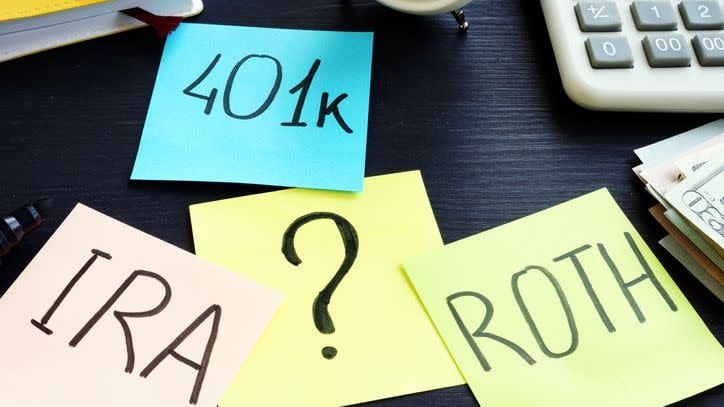SmartAsset and Yahoo Finance LLC may earn commission or revenue through links in the content below.
By your early 60s, you’ll likely be paying close attention to your finances and retirement savings. This may include making crucial decisions on investment structure, risk tolerance, income needs and tax planning, among the many other moving parts of your financial life.
A financial advisor can help you plan and save for retirement. Find a fiduciary advisor today.
Some households may consider whether they should switch to a Roth portfolio. Doing so can potentially save you considerably on taxes in retirement but comes at the cost of paying higher taxes upfront. This is true whether you switch Roth contributions or convert your existing savings into Roth funds. Here are a few things to think about if you’re considering a pivot to a Roth account
Pivoting vs. Converting to a Roth
For working households with existing savings, you typically have two options for adding a Roth account to your retirement plan. You can either start contributing to a Roth account or you can convert your pre-tax 401(k) into a Roth portfolio entirely.
Pivoting your contributions means diverting your annual savings – in whole or in part – to a Roth portfolio. For example, you might contribute less to your 401(k) and put that money into a Roth IRA instead. Given the low limits on Roth IRA contributions, many households will only pivot part of their retirement savings and put the rest in other accounts.
Doing a Roth conversion means moving the money that’s in a pre-tax account into a Roth IRA. There is no limit on how much money you can convert or how many conversions you’re allowed during your life. This makes conversions an effective loophole in the Roth IRA contribution caps. (Keep in mind that the IRS does limit you to one IRA rollover per year.)
In both cases, you must have an existing Roth portfolio to fund. While your employer will manage a Roth 401(k), opening a Roth IRA requires finding a brokerage that offers this product.
You can then fund your new account with ongoing contributions or convert your pre-tax assets into Roth funds. In both cases, the assets you put into the account must come from what’s called “earned income,” meaning that you made this money through pay or compensation rather than investment returns. A financial advisor can help you weigh the different options you have to save for retirement, including Roth rollovers.
Benefits of a Roth vs. Pre-Tax Account


The main difference between Roth accounts and pre-tax accounts is their tax treatment.
When contributing to a pre-tax account like a traditional IRA or 401(k), you receive a tax deduction on all contributions up to the program’s annual limit. In 2024, for example, a person can contribute up to $30,500 in tax-deductible funds to a 401(k). This makes it cheaper to fund these accounts and gives households more capital to invest.
But in retirement, you pay income taxes on everything you withdraw from your pre-tax account. This includes both principal and returns. Households can typically build up larger portfolios with a pre-tax account, but keep less of what they withdraw.
With a Roth account, you receive no tax benefit on your contributions. You pay income taxes on the money before it goes into your account. This makes it more expensive to fund these accounts, typically giving households less capital to invest. Note that this applies to converted funds as well. If you roll money over from a pre-tax account to a Roth account, you must count the entire amount toward your taxable income for that year.
By 59 ½, however, you pay no income taxes on any of the money you withdraw from a Roth account. This includes both principal and returns, meaning that a Roth portfolio generates untaxed returns over its lifetime. The upshot is households can typically build up smaller portfolios with a Roth account, but they keep everything they take out.
Roth accounts also aren’t subject to required minimum distributions (RMDs) – mandatory withdrawals that push your income higher and potentially vault you into a higher tax bracket. Consider working with a financial advisor if you need help planning for RMDs or managing your tax bill in retirement.
Should You Pivot or Convert?


Imagine that you’re 62 years old and married with $1.6 million in 401(k)s that you’re still contributing to. Should you stop all pre-tax contributions and pivot to Roth contributions? Should you do a Roth conversion instead? Or perhaps you should stand and continue making pre-tax contributions?
The right answer, of course, depends.
The rule of thumb is that a Roth account is more valuable the longer it grows because its gains are entirely untaxed. A Roth account is also more valuable when you pay a lower tax rate now compared to the rate you expect to pay in retirement.
A pre-tax account, on the other hand, is typically more valuable if you pay a higher tax rate today vs. the rate you’ll face in retirement.
The answer to the questions above can vary based on what you expect your taxes to be in retirement. How much taxable income do you anticipate having each year and what will that mean for your marginal tax rate?
For example, if you’re currently in the 24% tax bracket but you anticipate dropping into the 22% bracket in retirement, chances are that you’re better off forgoing the Roth pivot and/or rollover and sticking to your pre-tax contributions.
While this is a simple example, your household has probably reached or is nearing its peak income at age 62, and the odds are good that you’ll pay less in taxes once you retire. But review this carefully, ideally with a financial professional. With less time to grow and fewer tax benefits, a Roth pivot is less likely to benefit older households, but it depends entirely on your personal plans and tax situation. If you need help finding financial advice, this free tool can connect you with advisors who serve your area.
Bottom Line
For households approaching retirement, a Roth portfolio may hold less value than it would earlier in life. In general, Roth contributions are most valuable if you pay less in taxes today than you expect to pay in retirement. They are less valuable when you expect your tax bill in retirement to go down.
Roth Contribution Tips
-
Not every Roth account provided is created equal. Depending on your brokerage, you will get different services, investment opportunities and guidance. If you need help evaluating your options, here are some Roth IRA providers that you may want to consider.
-
A financial advisor can help you build a comprehensive retirement plan and manage your Roth accounts. Finding a financial advisor doesn’t have to be hard. SmartAsset’s free tool matches you with up to three vetted financial advisors who serve your area, and you can have a free introductory call with your advisor matches to decide which one you feel is right for you. If you’re ready to find an advisor who can help you achieve your financial goals, get started now.
-
Keep an emergency fund on hand in case you run into unexpected expenses. An emergency fund should be liquid — in an account that isn’t at risk of significant fluctuation like the stock market. The tradeoff is that the value of liquid cash can be eroded by inflation. But a high-interest account allows you to earn compound interest. Compare savings accounts from these banks.
-
Are you a financial advisor looking to grow your business? SmartAsset AMP helps advisors connect with leads and offers marketing automation solutions so you can spend more time making conversions. Learn more about SmartAsset AMP.
Photo credit: ©iStock.com/brizmaker, ©iStock.com/designer491, ©iStock.com/Anna Frank
The post We’re 62 and Have $1.6 Million in Our 401(k)s. Should We Pivot to Roth Contributions? appeared first on SmartReads by SmartAsset.


![Elon Musk calls for ‘deleting’ the Consumer Financial Protection Bureau [Video] Elon Musk calls for ‘deleting’ the Consumer Financial Protection Bureau [Video]](https://s.yimg.com/ny/api/res/1.2/2NROhrcYbdh_aJTy6uhXMQ--/YXBwaWQ9aGlnaGxhbmRlcjt3PTEyMDA7aD04MDA-/https://media.zenfs.com/en/aol_yahoo_finance_433/530d75ea5497f7e20ce377080b3e9264)











/cloudfront-us-east-1.images.arcpublishing.com/morningstar/5N6PBZJLMJEIXBH6EHTKPDK6NE.png)